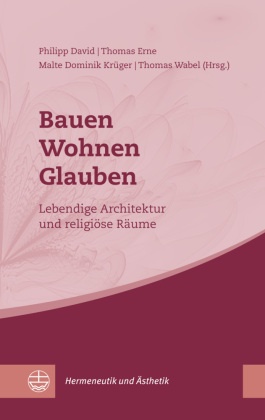
Bauen - Wohnen - Glauben - Lebendige Architektur und religiöse Räume
| Verlag | Evangelische Verlagsanstalt |
| Auflage | 2023 |
| Seiten | 408 |
| Format | 12,1 x 2,9 x 21,2 cm |
| Großformatiges Paperback. Klappenbroschur | |
| Gewicht | 441 g |
| Reihe | Hermeneutik und Ästhetik (HuÄ) 8 |
| ISBN-10 | 3374072151 |
| ISBN-13 | 9783374072156 |
| Bestell-Nr | 37407215A |
Wie wollen wir wohnen? In den Bauten einer Gesellschaft werden die Bilder sichtbar, die diese Gesellschaft von sich entwirft. Das betrifft die soziale, die ästhetische und die religiöse Dimension gesellschaftlichen Zusammenlebens. Der Sammelband erkundet die Wechselwirkungen zwischen funktionalen, ästhetischen, geistlichen und ethischen Aspekten im Blick auf "lebenswerte Architektur" im öffentlichen Raum. Die Beiträge fragen nach den Interdependenzen zwischen diesen Dimensionen und legen dabei besonderes Gewicht auf die wahrnehmbare Gestalt von Kirche in der Gesellschaft. Zurückgegriffen wird für diesen Zweck auf Konzepte des kultur- und sozialwissenschaftlichen "spatial turn". In ihnen wird Raum weniger als physisch-territorialer, sondern mehr als handlungstheoretischer Begriff betrachtet: Raum wird in einer sozialen und kulturellen Praxis hervorgebracht und unterstreicht Machtansprüche. Mit Beiträgen von Martina Bär, Anja Benoit, Tilman Beyrich, Philipp David,Heike Delitz, Marti n Düchs, Thomas Erne, Dirk Evers, Reinhard Hoeps, Paul-Gerhard Klumbies, Christl Maier, Thorsten Moos, Udo Schnelle, Ute Verstegen, Thomas Wabel, Christopher Zarnow.[Building - living - believing. Vibrant architecture and religious roomes]How do we want to live? In the buildings of a society, the images that this society creates of itself become visible. This affects the social, the aesthetic and the religious dimensions of social coexistence. The anthology explores interactions between functional, aesthetic, spiritual and ethical aspects in view of a »livable architecture« in public space. The contributions ask about the interdependencies between these dimensions and place a particular emphasis on the perceptible form of the church in society. For this purpose, concepts of the cultural and social-scientific »spatial turn« are used. According to this perspective, space is viewed less as a physical-territorial concept and more as an action-theoretical concept: space is created in s ocial and cultural practice and underlines claims to power.
